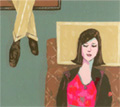To understand and explain psychoanalysis, Sigmund Freud tirelessly repeated to his young colleagues, one must always “stick to the clinic.” Since it often consists of painfully speaking, saying, and sharing the most intimate parts of oneself, depth psychology still arouses questions and mistrust more than a hundred years after its creation, despite some significant successes. All the more reason to delve into these “couch stories and armchair discussions,” an impressive collection of testimonials from former analysands (the book sometimes refers to them as “analyzed” for educational purposes), including media-famous individuals (Charles Berling, Frédéric Mitterrand, Marie Darieussecq) and illustrious unknowns, who all have “lain down” for a time on a professional’s couch. In total, several “slices of life” are intertwined with comments from two well-known psychologists, all under the supervision of a journalist from Le Figaro, an appreciated author of children’s books that enjoyed some success among parents (“Little stories to grow up,” “Read at night to address with the child, their fears, their troubles, their questions,” followed by “Tales to learn how to take care of them,” Albin Michel 2003 and 2005).
“Mourning, body impasse, maternal dominance, or quest for the father,” no subject seems spared the reader, whether a layperson or reluctant to analysis, who can thus become more acquainted with the “approach” without voyeurism or false modesty. Everything starts with the meanders in the choice of one’s future analyst whose name, sex, proximity or geographical distance from home, renown or discretion are criteria with undeniable unconscious extensions. Then comes the initial face-to-face meeting, essential for this “common experience,” this original feeling that sets or undermines the foundations of future work. Following are the beginnings of transference, perceptible in the patient who “brings” his first enigmatic dreams and whose gaze, seeming to escape that of the analyst, begins to sweep the space of the office to then spot and exploit objects as so many supports to his unconscious symbolic elaborations. Thus, each of these “analyzed,” whether in terms of weeks, months, or years, recounts resistances, discouragements, bright spells, significant moments as well as apparently hollow sessions, all told with a courage imbued with humor or supported by emotion.
“We are the surrogate mothers of the unconsciousness of others,” the psychoanalyst Jean Laplanche once said in a memorable phrase. It is still difficult, however, to explain to the novice who has never experienced the couch, the nature and content of this very particular inner experience. At most, one can tell them, without wanting to quibble with the truth, that psychoanalysis, far from providing all the answers, will at least have the merit of exhausting the sense of many of their questions.
Sophie Carquain and Maryse Vaillant, “Couch Tales, Armchair Discussions, How Psychoanalysis Can Change Life,” Editions Albin Michel, 2007, 371 p., 20 Euros.


